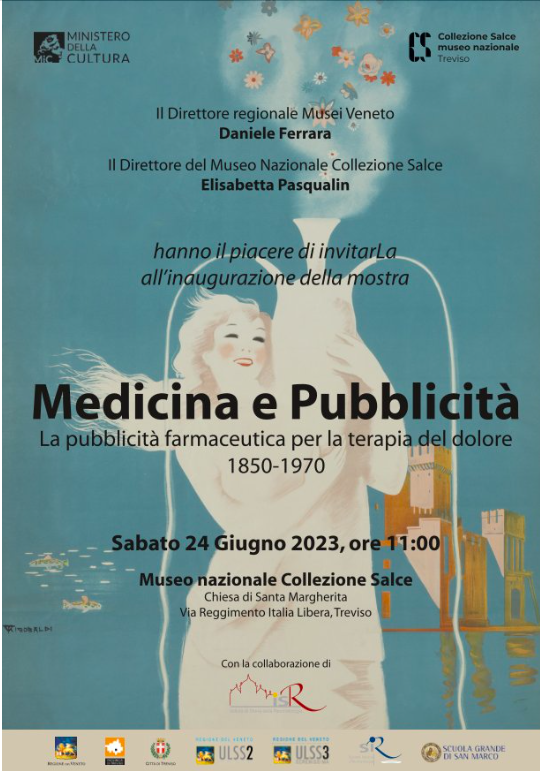The exhibition Medicine and Advertising. Pharmaceutical advertising for pain therapy 1850 – 1970, edited 
A particular piece was chosen from the Museum's collection, which tells how some drugs that appeared between 1850 and 1970 were advertised to combat the different types of pain associated or not with rheumatological diseases, which are widespread and very disabling.
It should come as no surprise that the research of many pharmaceutical companies has had the objective of producing and placing on the market above all painkillers, presented with communicative methods that focus on the goodness of the product and its peculiarity. The value and significance of the works conserved at the Museo Nazionale Collezione Salce in Treviso are further underlined by the fact that many of these products are still part of our daily life. Others, however, have been withdrawn from the market because they are obsolete or dangerous to health, including some opioid drugs containing cocaine, heroin, methadone or morphine.
The exhibition is divided into a historical and explanatory part on the ground floor, enriched by brief biographical introductions to the three major artists present in the exhibition, Cappiello, Dudovich and Mauzan.
It continues on the upper floor, where, on the exhibition terrace, the images of the great poster artists tell the stories of ailments and their remedies in a sometimes amusing, sometimes austere way: from headaches, colds and sore throats, coughs, gout , and therefore Aspirin, plasters and many other medicines. An interesting overview of drugs once used, now less used, if not carefully avoided.
One section is dedicated to the advertising of the major spa resorts, with enchanting images of places immersed in nature, with dream hotels, of sure emotional impact.
The posters are displayed as always with no filters between the viewer and theposter, to re-propose the direct effect – sometimes unsettling – that the passer-by could experience walking along the city streets
“The intent of this exhibition is to tell one of the aspects of our culture between the mid-1800s and the 20th century. It is the moment in which even pharmaceutical companies begin to perceive the power of the medium that was being born, advertising, and to use it to promote their products. Advertising is art and let's not forget that these posters were found on the streets, in stations, in full view of everyone, rich and poor, combining a very high artistic value with an important social and cultural value." points out Elizabeth Pasqualin, director of the National Museum of the Salce Collection in Treviso.
“We are proud to have promoted such a significant project – he says Leonardo Punzi, director of the Institute of History of Rheumatology – who underlines the importance of advertising, born in the mid-19th century and immediately placed at the service of the population, in need of numerous medicines, especially painkillers. In those days, analgesics were opium derivatives, including morphine, heroin and cocaine, but their negative effects were ignored and, indeed, their consumption was promoted even among the youngest. The first 'modern' painkiller was Aspirin, born in 1897, a real revolution in the pharmaceutical market, with an important impact also on the advertising of medicines.”
The exhibition tells all of this, winking at the well-being that society has achieved and showing us how much progress has been made since then.
Event date:
Medicine and Advertising
Pain therapy pharmaceutical advertising 1850 – 1970
Salce Collection National Museum
Santa Margherita – Free Italy regiment street, TREVISO
Inauguration
Saturday 24 June, 11 am
24 June – 8 October 2023
from Friday to Sunday 10-18
